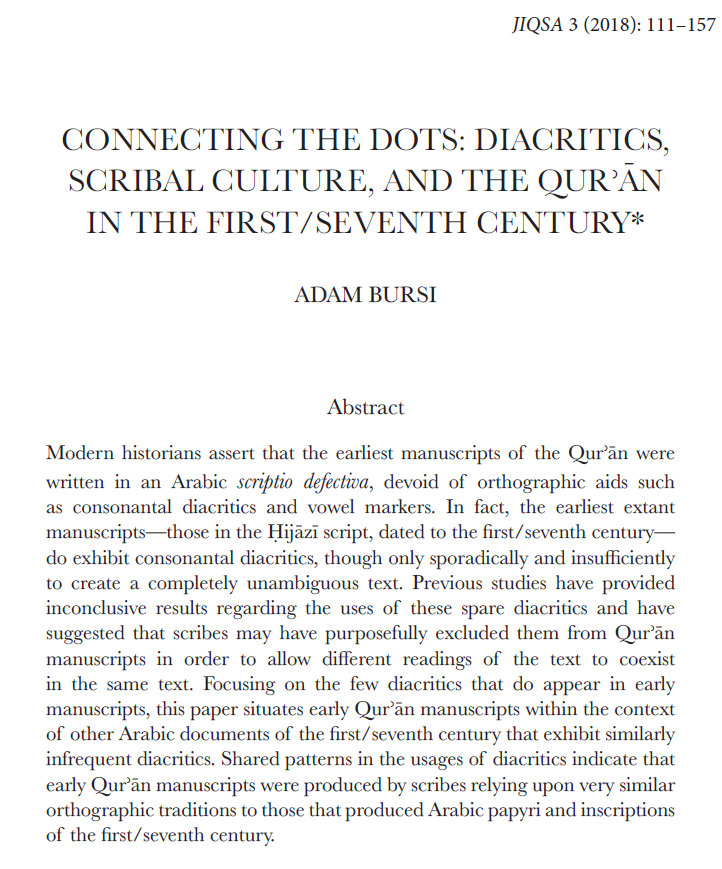
A strong argument for an oral tradition of the Quran in parallel to the written text that I've heard is that even with the Muqaṭṭaʿāt, there is consensus of the reading, while ٮس (Q36:1) could have been read in 10 different ways. Does it hold up in manuscript evidence? 🧵 

This argument rests on the assumption that the original codices of Uthman were undotted. This is likely a myth. Every early Quranic manuscript has sporadic dotting, there is no reason to believe that the original Uthmanic master copies were different. See @Adam_Bursi's article. 

So what about the few dotted Muqaṭṭaʿāt? How do they show up in early manuscripts? Do they have dots? Is the consensus because the text was simply unambiguous? This is something we can check, so let's have a look what early manuscripts show!
Q19:1 kā-hā-yā-ʿayn-ṣād
1. Saray Medina 1a: Dotted yāʾ.
2. Wetzstein II 1913: No dots.
3. Ma VI 165: No dots.
4. Or. 2165: No dots.
So undotted seems like the norm here. But all readers agree that the third of these letters is yāʾ, seems like genuine oral tradition.



1. Saray Medina 1a: Dotted yāʾ.
2. Wetzstein II 1913: No dots.
3. Ma VI 165: No dots.
4. Or. 2165: No dots.
So undotted seems like the norm here. But all readers agree that the third of these letters is yāʾ, seems like genuine oral tradition.




Q36:1 yā-sīn
1. Saray Medina 1a: No dots.
2. Wetzstein II 1913: Strongly retouched, but no apparent dotting.
3. Ma VI 165: No dots.
4. Is. 1615 I: No dots.
So indeed, the consensus on yā-sīn, despite potentially 5 (or even 10) different readings seems significant.



1. Saray Medina 1a: No dots.
2. Wetzstein II 1913: Strongly retouched, but no apparent dotting.
3. Ma VI 165: No dots.
4. Is. 1615 I: No dots.
So indeed, the consensus on yā-sīn, despite potentially 5 (or even 10) different readings seems significant.




There other dotted muqaṭṭaʿāt are less significant. Final nūn and qāf have unique shapes that cannot be confused with any other letter in the early Arabic scripts. But still the can be dotted, so let's have a look what they do in Q42:1, Q50:1 and Q68:1.
Q42:1 ḥā-mīm ʿayn-sīn-qāf
1. Saray Medina 1a: no dots.
2. Wetzstein II 1913: no dots.
3. Or. 2165: no dots.
4. Is. 1615 I: no dots.
Codex Parisino Petropolitanus (not pictured) likewise has no dots here.



1. Saray Medina 1a: no dots.
2. Wetzstein II 1913: no dots.
3. Or. 2165: no dots.
4. Is. 1615 I: no dots.
Codex Parisino Petropolitanus (not pictured) likewise has no dots here.




Q50:1 Qāf
1. Saray Medina 1a: no dots.
2. Wetzstein II 1913: one dot below! (Typical way of dotting Qāf in early manuscripts).
3. Arabe 331: no dots.
4. DAM 01-29.1: no dots.
Typical that a letter that is not ambiguous at all would get dotted in one of these manuscripts.



1. Saray Medina 1a: no dots.
2. Wetzstein II 1913: one dot below! (Typical way of dotting Qāf in early manuscripts).
3. Arabe 331: no dots.
4. DAM 01-29.1: no dots.
Typical that a letter that is not ambiguous at all would get dotted in one of these manuscripts.




Q68:1 Nūn
1. Saray Medina 1a: Dotted!
2. Wetzstein II 1913: Dotted!
Sadly this Sūrah is not well attested in early manuscripts. But it's super typical that final Nūn which cannot be confused with any other letter and therefore DOESN'T need a dot gets dotted in both manuscripts!

1. Saray Medina 1a: Dotted!
2. Wetzstein II 1913: Dotted!
Sadly this Sūrah is not well attested in early manuscripts. But it's super typical that final Nūn which cannot be confused with any other letter and therefore DOESN'T need a dot gets dotted in both manuscripts!


This is a more typical pattern. In our earliest manuscripts for some bizarre reason, the nūn, of all letters, is frequently dotted by scribes, while that dot bears no functional load. This is something seen in early papyri too. It still requires a satisfying explanation...
So yes, even in light of manuscript evidence and the knowledge that dotting may have been present in the earliest master copies, those dottings do not seem to have given rise to the knowledge that you're suppose to read yā-sīn and not, say, bā-šīn. There was oral knowledge.
Thanks to @TentStitcher for this original question. It had never occurred to me to check. The results are exactly as expected (I even predicted the dotting of the nūn!), but always good to follow up on it.
https://twitter.com/TentStitcher/status/1468667677883383811
If you enjoyed this thread and want me to do more of it, you can support me on Patreon (patreon.com/PhDniX) or Ko-Fi (ko-fi.com/phdnix). If I hit 400 euros a month on Patreon, I will start publishing exclusive monthly updates of a Critical Edition of the Quran!
ADDENDUM: A question made me realize that I should perhaps have explained what the Muqaṭṭaʿāt are for some of the readers seeing this thread. I'll just put that here.
https://twitter.com/PhDniX/status/1468689371176087557
• • •
Missing some Tweet in this thread? You can try to
force a refresh












